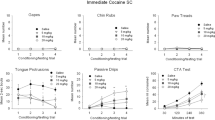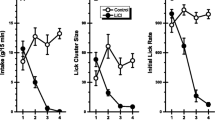Abstract
The process of selective associations is evident in the aversive conditioning literature, where it has been shown that external cues are readily associated with peripheral pain, whereas taste cues are more easily associated with effects of drug administration. Within this framework, it is of interest that the failures to obtain a conditioned analgesic response to a morphine-associated CS have used external cues as conditioned stimuli. In Experiment 1, subjects re-exposed to a morphine-associated CS not only expressed the anticipated taste aversion, but also exhibited a decrease in pain sensitivity that was evident 15 or 30 min following CS re-exposure. Experiment 2 suggested that the conditioned analgesic response was opioid mediated, as pre-test administration of naloxone blocked expression of the analgesic CR. In Experiment 3, an increase in opiate receptor sensitivity produced by chronic naltrexone treatment did not affect the strength of the taste aversion, but resulted in an increase in the magnitude of the conditioned analgesic response. Collectively, these data suggest a neuropharmacological dissociation in systems mediating the two responses.
Similar content being viewed by others
References
Adams WH, Yeh SY, Woods LA, Mitchell CL (1969) Drug-test interaction as a factor in the development of tolerance to analgesic effect of morphine. J Pharmacol Exp Ther 168:251–257
Advokat C (1980) Evidence for conditioned tolerance of the tailflick reflex. Behav Neural Biol 29:385–389
Advokat C (1981a) Analgesic tolerance produced by morphine pellets is faciliated by analgesic testing. Pharmacol Biochem Behav 14:133–137
Advokat C (1981b) Environment modulation of analgesic tolerance induced by morphine pellets. Pharmacol Biochem Behav 14:139–142
Audigier Y, Mazarguil H, Gout R, Cross J (1980) Structure-activity relationships of enkephalin analogs at opiate and enkephalin receptors: correlation with analgesia. Eur J Pharmacol 63:35–46
Bardo MT, Hughes RA (1979) Exposure to a nonfunctional hot plate as a factor in the assessment of morphine-induced analgesia and analgesic tolerance in rats. Pharmacol Biochem Behav 10:481–485
Bardo MT, Bhatnagar RK, Gebhart GF (1983a) Age-related differences in the effect of chronic administration of naloxone on opiate binding in the rat brain. Neuropharmacology 22:453–461
Bardo MT, Bhatnagar RK, Gebhart GF (1983b) Chronic naltrexone increases opiate binding in brain and produces supersensitivity to morphine in the locus coeruleus of the rat. Brain Res 289:223–234
Bardo MT, Miller JS, Risner ME (1984a) Opiate receptor supersensitivity produced by chronic naloxone treatment: dissociation of morphine-induced antinociception and conditioned taste aversion. Pharmacol Biochem Behav 21:591–597
Bardo MT, Miller JS, Neisewander JL (1984b) Conditioned place preference with morphine: extinction of the reinforcing CR. Pharmacol Biochem Behav 21:545–549
Bechara A, van der Kooy D (1985) Opposite motivational effects of endogenous opioids in brain and periphery. Nature 314:533–534
Ben-Barak J, Dudai Y (1980) Scopolamine induces an increase in muscarinic receptor level in rat hippocampus. Brain Res 193:309–313
Blander A, Hunt T, Blair R, Amit Z (1984) Conditioned place preference: an evaluation of morphine's positive reinforcing properties. Psychopharmacology 84:124–127
Bloom FE, Siggins GR, Henriksen SJ (1981) Electrophysiologic assessment of receptor change following chronic drug treatment. Fed Proc 40:166–172
Burt DR, Creese I, Snyder SH (1976) Chronic treatment elevates dopamine receptor binding in brain. Science 196:326–328
Cappell H, LeBlanc AE (1973) Aversive conditioning by psychoactive drugs: effects of morphine, alcohol, and chloridazepoxide. Psychopharmacologia 29:239–246
Chang KJ, Cuatrecasas P, Wei ET, Chang JK (1982) Analgesic activity of intracerebroventricular administration of morphiceptin and B-casomorphins: correlation with the morphine (μ) receptor binding affinity. Life Sci 30:1547–1551
Coyle JT, Pert CB (1976) Ontogenetic development of3H-naloxone binding in rat brain. Neuropharmacology 15:555–560
de Sousa BN, Horrocks LA (1979) Development of rats spinal cord: I. Weight and length with a method for rapid removal. Dev Neurosci 2:115–121
Fanselow MS (1984) Shock-induced analgesia on the formalin test: effects of shock severity, naloxone, hypophysectomy, and associative variables. Behav Neurosci 98:79–95
Fanselow MS, Baackes MP (1982) Conditioned fear-induced opiate analgesia on the formalin test: evidence for two aversive motivational systems. Learn Motiv 13:200–221
Farber PD, Gorman JE, Reid LD (1976) Morphine injections in the taste aversion paradigm. Physiol Psychol 4:365–368
Garcia J, Koelling RA (1966) The relationship of cue to consequence in avoidance learning. Psychon Sci 4:123–124
Helmstetter FJ, Fanselow MS (1987) Effect of naltrexone on learning and performance of conditioned fear-induced freezing and opioid analgesia. Physiol Behav 39:501–505
Katz RJ, Gormezano G (1979) A rapid inexpensive technique for assessing the reinforcing properties of opiate drugs. Pharmacol Biochem Behav 11:231–233
Kelly DD (1982) Central representations of pain and analgesia. In: Kandel ER, Swartz TH(eds) Principles of Neuroscience Elsevier, North Holland
Lahti RA, Collins RJ (1978) Chronic naloxone results in prolonged increases in opiate binding sites in brain. Eur J Pharmacol 51:185–186
Lord JAH, Waterfield AA, Hughes H, Kosterlitz HW (1977) Endogenous opiate peptides: multiple agonists and receptors. Nature 267:495–499
Matzel LD, Miller RR (1987) Recruitment time of conditioned opioid analgesia. Physiol Behav 39:135–140
McKinney M, Coyle JT (1982) Regulation of neocortical muscarinic receptors: effects of drug treatment and lesions. J Neurosci 2:97–105
Mucha RF, Herz A (1985) Motivational properties of kappa and mu opioid receptor agonists studied with place and taste preference conditioning. Psychopharmacology 86:274–280
Mucha RF, Herz A (1986) Preference conditioning produced by opioid active and inactive isomers of levorphanol and morphine in the rat. Life Sci 38:241–249
Miller JS (1987) Conditioning of morphine-induced taste aversion and analgesia. Doctoral dissertation, University of Kentucky.
Miller JS, McCoy DF, Kelly KS, Bardo MT (1986) A within-event analysis of taste-potentiated odor and contextual aversions. Anim Learn Behav 14:15–21
Muller P, Seeman P (1978) Dopaminergic supersensitivity after neuroleptics: time course and specificity. Psychopharmacology 60:1–11
Murugaiah K, Theodorou A, Mann A, Clow A, Jenner P, Marsden CD (1982) Chronic continuous administration of neuroleptic drugs alters cerebral dopamine receptors and increases spontaneous dopaminergic action in the striatum. Nature 296:570–572
Paletta MS, Wagner AR (1986) Development of context-specific tolerance to morphine: support for a dual-process interpretation. Behav Neurosci 100:611–623
Pert CB, Snyder SH (1976) Opiate receptor binding — enhancement by opiate administration in vivo. Biochem Pharmacol 25:847–853
Riley AL, Jacobs WJ, LoLordo VM (1978) Morphine-induced taste aversions: a consideration of parameters. Physiol Psychol 6:96–100
Ross RT (1985) Blocking and unblocking of conditioned analgesia. Learn Motiv 16:173–189
Ross RT (1986) Pavlovian second-order conditioned analgesia. J Exp Psychol [Anim Behav] 12:32–39
Ross RT, Randich A (1984) Unconditioned stress-induced analgesia following exposure to a brief footshock. J Exp Psychol [Anim Behav] 10:127–137
Ross RT, Randich A (1985) Associative aspects of conditioned analgesia evoked by a discrete CS. Anim Learn Behav 13:419–431
Rossi NA, Reid LD (1976) Affective states associated with morphine injections. Physiol Psychol 4:269–274
Seeman P (1980) Brain dopamine receptors. Pharmacol Rev 32:229–313
Sherman JE (1979) The effects of conditioning and novelty on the rat's analgesic and pyretic response to morphine. Learn Motiv 10:383–418
Sherman JE, Pickman C, Rice A, Liebeskind JC, Holman EW (1980) Rewarding and aversive effects of morphine. Temporal and pharmacological properties. Pharmacol Biochem Behav 13:501–505
Siegel S (1975) Evidence from rats that morphine tolerance is a learned response. J Comp Physiol Psychol 89:498–506
Siegel S (1976) Morphine analgesic tolerance: its situation specificity supports a Pavlovian conditioning model. Science 193:323–325
Siegel S (1977) Morphine tolerance as an associative process. J Exp Psychol [Anim Behav] 3:1–13
Siegfried B, Netto CA, Izquierdo I (1987) Exposure to novelty induces naltrexone-reversable analgesia in rats. Behav Neurosci 101:346–348
Smotherman WP (1985) Glucocorticoid and other hormonal substrates of conditioned taste aversion. Ann NY Acad Sci 443:126–144
Tang AH, Collins RJ (1978) Enhanced analgesic effects of morphine after chronic administration of naloxone in the rat. Eur J Pharmacol 47:473–474
Tempel A, Zukin RS, Gardner EL (1982) Supersensitivity of brain opiate receptor subtypes after chronic naltrexone treatment. Life Sci 31:1401–1404
Tempel A, Gardner EL, Zukin RS (1985) Neurochemical and functional correlates of naltrexone-induced opiate receptor upregulation. J Pharmacol Exp Ther 232:439–444
Watkins LR, Mayer DJ (1982) Organization of endogenous opiate and nonopiate pain control systems. Science 216:1185–1192
Wolfe BB, Harden J, Sporn JR, Molinoff PB (1978) Presynaptic modulation of beta adrenergic receptors in rat cerebral cortex after treatment with antidepressants. J Pharmacol Exp Ther 207:446–457
Wood PL, Charleson SE, Lane D, Hudgin RL (1981) Multiple opiate receptors: Differential binding of μ, κ, and σ agonists. Neuropharmacology, 20:1215–1220
Author information
Authors and Affiliations
Rights and permissions
About this article
Cite this article
Miller, J.S., Kelly, K.S., Neisewander, J.L. et al. Conditioning of morphine-induced taste aversion and analgesia. Psychopharmacology 101, 472–480 (1990). https://doi.org/10.1007/BF02244224
Received:
Revised:
Issue Date:
DOI: https://doi.org/10.1007/BF02244224




